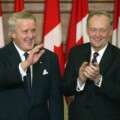It is unsurprising that the Alberta government has ordered its province’s striking teachers back to work. What’s perhaps surprising is the way it did it.
Premier Danielle Smith’s government has invoked the Charter’s Section 33 “notwithstanding clause”The notwithstanding clause is the term for Section 33 of the Charter of Rights and Freedoms. The clause enables legislatures to enact laws that cannot be judicially reviewed and struck down by courts under certain sections of the Charter (for renewable five-year periods). Alberta is invoking the clause to avoid judicial challenges to the legislation under the Charter’s section 2(d) right to freedom of association. in legislation, ordering Alberta’s public-school teachers, who have been on strike since Oct 6th after teachers voted 89.5 percent against a deal, back into the classroom.
Smith’s invocation of Section 33 is bound to generate criticism from the union as well as critics of the clause more generally. Many will likely cite former Alberta premier Peter Lougheed’s evolving reservations about the notwithstanding clause in their critiques. Yet the history is quite clear: Based on Lougheed’s own views of Section 33 during his time in office, it’s quite likely that he would have supported Smith’s invocation of it in this instance.

Why use Section 33?
The Back to School Act 2025 legislatively imposes the collective agreement that the teachers voted down prior to striking. It increases salaries for teachers (including substitutes) up to a total of 12 percent by 2027 and commits to hiring 3,000 new teachers by 2028 and 1,500 new educational assistants by 2028.
If the province did not include the notwithstanding clause in the law, the teachers’ union could seek to enjoin or invalidate the law under the Supreme Court’s section 2(d) freedom of association jurisprudence. It is possible that the province could win such a challenge in court, but it could also lose (and Alberta recently had its trans policies enjoined by a recently appointed trial court justice on highly questionable grounds). Any litigation would arguably draw out the negotiation process and de facto strengthen the teachers’ hand.
Invoking Section 33 does not end the policy discussion, it merely prevents courts from intervening on the side of the teachers by way of Charter litigation. When Ontario Premier Doug Ford invoked the clause in 2021, the teachers disobeyed the back-to-work legislation and ended up compromising with the Ontario government. The clause did not end the debate.
The invocation of Section 33 is sure to raise condemnation, not just from many of the teachers, but from many in Canadian academia and the commentariat who have convinced themselves that the most democratic and federalist part of the Charter is somehow the antithesis of liberal democracy.
Lougheed’s view
What would Lougheed, the Progressive Conservative Alberta premier who championed (alongside Saskatchewan’s NDP Premier Alan Blakeney) the notwithstanding clause in the patriation negotiations, make of Smith’s use of Section 33? Fortunately, we don’t need narcotics or Prime Minister Mackenzie King’s Ouija board to consult the wisdom of Lougheed. We have his thoughts in print on the topic of sSection 33 and the Charter right to freedom of association.
In 1983, Lougheed’s government enacted the Public Service Employee Relations Act, which prevented hospital workers from going on strike. The union representing the hospital workers sought to challenge the law based on the view that the Charter right to freedom of association protected a constitutional right to strike. Lougheed’s government declared that if the Supreme Court invalidated the provisions under the right to strike, Alberta would re-enact its strike prohibition laws with invocations of the Section 33 notwithstanding clause.
In his reflections on this episode, Lougheed defended this position as preferable to preemptively enacting laws invoking Section 33. But in the 2008 Saskatchewan Federation of Labour v Saskatchewan case, the Supreme Court decided to grant “constitutional benediction” to the right to strike. The Supreme Court’s interpretation of the Charter means that Lougheed’s caution is no longer warranted in this area of law. Courts are now poised to enjoin or strike down laws that restrict the right of public unions to strike.
The logic of Lougheed’s argument is clear: Given that the Supreme Court has granted unions a constitutional right to strike, it is reasonable for a legislature to invoke Section 33 to constitutionally prevent public servants like hospital workers or teachers from using that right to seek rents and influence public policy.
It is possible that Lougheed would have taken different negotiating tactics than Smith. But he saw no coherent constitutional objection to using Section 33 to contest judicial interference in labour relations in the face of judicial activism.
A reasonable response
The details of the labour dispute make it all the more reasonable for Alberta to invoke Section 33. Alberta’s labour dispute does not merely concern teacher pay but also wider public policy matters, such as demands for more teachers and more classrooms. Questions about how many teachers the province should hire and how many new schools it should build are obviously connected to the working conditions teachers face, but they are also matters of democratic public policy that courts are particularly ill-suited to address.
If the province hires more teachers, it will have less room in the budget for other important policies, e.g. doctors and nurses in health care. If the province builds more schools, it may have less funds to build hospitals or other important infrastructure. Or it may have to borrow more if it isn’t willing to contain costs. Why should unelected courts be part of these complex public policy trade-offs?
And there is yet another layer to this controversy, which is that the Liberal federal government is currently goading the Supreme Court to de facto amend the Constitution to set limits on Section 33 that are not found in the text or history of the Charter. The reason for this is easier to understand once we note that the provinces have enacted at least 26 different laws using Section 33, while the federal Parliament has never invoked the clause. Why is that?
There are a number of explanations for this disparity, but one of the most important factors is that the federal government controls appointments to all Canadian appellate courts, including the Supreme Court. As such, the federal government can influence the judicial process over the long haul in a way that the provinces cannot. The provinces need Section 33 as a way of contesting judicial decisions about Charter rights that they cannot influence via appointments.
Alberta’s use of Section 33 in this context highlights how the federal Liberals’ move to limit the notwithstanding clause would further handcuff the ability of provinces to deal with important rights questions and policy trade-offs in their jurisdiction.
Understanding the political dynamics underlying the increasing provincial use of the notwithstanding clause since 2018 is itself an interesting topic. But it seems even more puzzling to me why so many commentators appear to be scandalized by this phenomenon and unwilling to think about the power dynamics in play.
As provincial costs in public sectors such as education and health care continue to grow, it would be bizarre if provinces did not avail themselves of the one constitutional tool that allows them to override the ability of public unions to use courts to extract rents and influence public policy.
And if the Canadian economy slides into a recession, we can expect the political value of the notwithstanding clause to go up, not down. Our appreciation for Lougheed’s constitutional wisdom should rise accordingly.
Is the notwithstanding clause a tool for democratic accountability or a threat to rights?
How does Alberta's use of the notwithstanding clause impact the balance of power between provinces and the federal government?
What are the economic implications of using the notwithstanding clause in labor disputes?











Comments (1)
Thank you for you analysis of this. It gives me a fuller understanding of the scope of the affects of the strike and the influence it has on governance in Alberta.